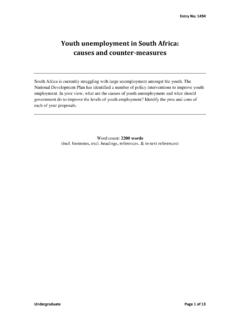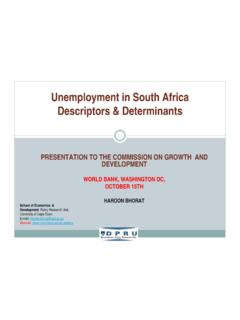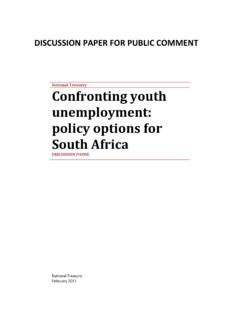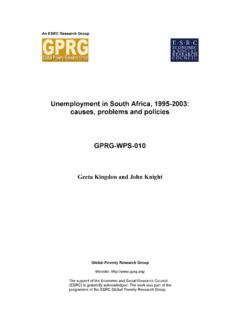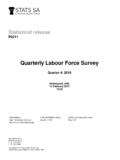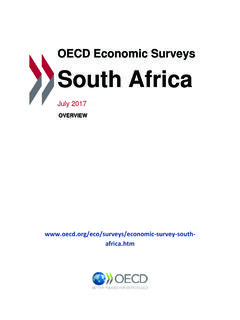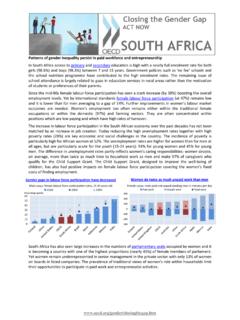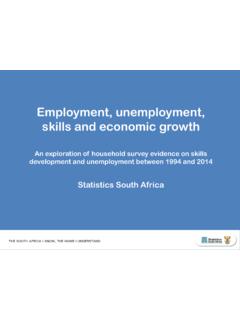Transcription of Two Policies to Alleviate Unemployment in South …
1 Two Policies to Alleviate Unemployment in South AfricaJames Levinsohn Ford School of Public PolicyUniversity of Michigan and NBERA ugust 28, 20071 IntroductionAt transition in 1994, the new South African government inherited an economy that hadsystematically disadvantaged most of the population. For almost a half century, Blacks1had been subject to an intentionally second-class education, labor laws that precluded theiradvancement, business regulations that outlawed many forms of firm ownership, and lawsthat kept them from living in the metropolitan areas that were the center of was about 15 percent.
2 A dozen years later and all of these restrictionsof the Apartheid system have disappeared from the law. Over this same period, unem-ployment has about doubled, and the same groups that struggled under Apartheid nowdisproportionately bear the costs of this are multiple reasons for the increase in Unemployment . South africa has been subjectto the same skill-biased technological change as many other parts of the world and this hashit especially hard in the mining and agriculture sectors precisely where many unskilledBlacks worked. Concurrently, there was a huge influx of mostly under-educated Blackwomen into the labor market just as the demand for less skilled workers declined.
3 Thisincrease in labor supply coupled with a decline in labor demand would have led to wagedeclines that society found unacceptable, and the result has been a substantial increase Thanks to Taryn Dinkelman, Yazir Henri, Zoe McLaren, and Vimal Ranchhod, as well as fellow CIDpanel members for helpful comments. Thanks also to the staff at the National Treasury and the Presidencyfor access, advice, and assistance. A special thanks is due to Ricardo Hausman whose ideas on policyimplementation are front and center in this refer to non-Whites in this paper as Blacks. This group includes the population groups labeledAfrican, Indian/Asian, and Coloured in South African statistical companion paper to this one documents the increase in Unemployment and discusses in much greater1 The socio-economic costs of this Unemployment are at least three-fold.
4 First, unemployedSouth Africans represent lost economic output today. A back-of-the-envelope calculationillustrates the magnitude of this cost. If employment as a fraction of the total populationrose to the level of an average of 6 comparator countries, per capita GDP in South Africawould rise by 48 percent. To put this in perspective, the current South African economicgrowth plan, ASGI-SA, has set as its goal an increase in per capita GDP of 38 percentby 2014. Hence, if employment as a fraction of the population were to rise to the level ofcomparator countries, the entire ASGI-SA goal would be more than second cost of South africa s high Unemployment reflects the dynamic aspects of unem-ployment.
5 Workers who are unemployed today are not acquiring the experience and skillsthat will contribute to their productivity in the future. Hence the static costs of unem-ployment discussed above are amplified over time. An implication of this is that waiting toaddress Unemployment is increasingly costly in terms of foregone future growth. Further-more, the dynamics are such that Unemployment is not a self-correcting third cost is harder to measure but just as important. Unemployment contributesto the social ills that accompany a loss of hope. These include crime, disengagementwith the political process, and a lack of investment in one s future well-being.
6 Becauseunemployment is concentrated among adults under the age of 35, their disillusionment withthe new South africa carries with it a particular threat to the future of the all these reasons and more, Unemployment is probably the single most pressing chal-lenge facing South africa today. This paper proposes two specific policy responses toSouth africa s Unemployment responses that are tailored to the idiosyncracies of theSouth African labor market. The first policy is a targeted wage subsidy, and the second isimmigration reform to encourage highly skilled remainder of the paper is organized as follows.
7 Section 2 provides a brief overviewdetail why this has occurred. See [1].3 The comparator countries are Malaysia, Mexico, Thailand, Turkey, Poland, and Venezuela. The detailsof the calculation are as follows. Employment as a share of the total population is the product of the shareof the population that is working age times the share of the working age population that is in the laborforce times the share of the labor force that is employed. The calculation is done using aggregate data fromthe World Bank s World Development indicators. This calculation highlights the fact that the labor forceparticipation rate (the fraction of the population in the labor force) is the driving factor in this africa s labor force participation rate is one of the lowest in the world.
8 In 2001, the only reportingentities with lower rates were West Bank and Gaza, Algeria, Syria, and Saudi Arabia countries wherefemale labor force participation is not especially can of course change the list of comparator countries and obtain different results, but the mainmessage is robust low labor force participation coupled with low employment of those in the labor forcecreate a very binding constraint on South African economic alternative view of how to address the Unemployment problem can be found in [4]. That studyhas several policy recommendations, but focuses heavily on providing subsidized credit for the dimensions of Unemployment in South africa .
9 This section provides a set of factsthat any policy to address Unemployment must confront. Section 3 proposes the targetedwage subsidy and discusses implementation details, costs, as well as the more generaleconomic reasoning behind the policy proposal. Section 4 proposes immigration 5 addresses links between the proposed Policies and two other areas of economicpolicy industrial policy and Black Economic Empowerment (BEE). Section 5 also discussestwo other possible policy responses to Unemployment education reform and public worksprograms. Section 6 The Context South africa s labor marketAny policy to address Unemployment must come to terms with the details of the SouthAfrican labor market.
10 While there are many ways to examine the data, four patternsare key. First, Unemployment as well as labor force participation have risen over thepast decade. The levels of Unemployment by both narrow and strict definitions are quitehigh. Second, Unemployment is not evenly distributed across the age spectrum. Rather, Unemployment is concentrated among the younger cohorts. Third, Unemployment is higheven for those with a Matric, but is close to zero for those who have completed a universitydegree. Fourth, transitions from Unemployment into the formal sector are rare as aretransitions from the informal sector to the formal sector.










